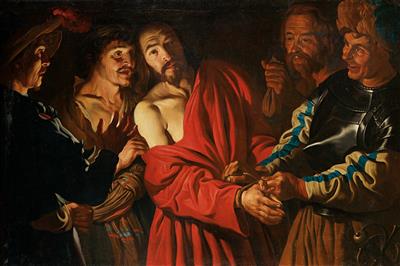Workshop of Matthias Stomer

(Amersfoort circa 1600 - after 1652 Sicily? or Northern Italy)
The Capture of Christ,
oil on canvas, 105 x 155 cm, framed
Provenance:
European Private Collection
The present painting renders the biblical scene in powerful chiaroscuro. Its dynamic composition as a nocturnal scene is reminiscent of works by Honthorst, but its more dramatic approach and the pronounced light contrasts betray Neapolitan influences, suggesting that the painter must be very close to Matthias Stomer. The focus is on the figure of Christ, depicted in the centre of the composition in austere monumentality. The scene depicts the very moment in which Christ’s hands are being bound, his outstretched arms emphasising the picture’s diagonal layout. Four further figures are grouped around Christ in a complex arrangement; Judas with the money pouch is discernible in the right background. The motifs of the Capturet and the Mocking of Christ frequently recur in the oeuvres of Stomer and his circle. Comparable compositions can be found in Stomer’s Arrest of Christ in the National Gallery of Canada in Ottawa, in the Ecce Homo in the Rijksmuseum, Amsterdam, and in the painting Christ and the Adultress, with Alberto Algranti, Milan (see B. Nicolson, Caravaggism in Europe, vol. III, Oxford 1979, figs. 1463, 1481, 1509).
Tradition has it that Stomer, who in old sources is mostly referred to as ‘Stom’, came from Amersfoort near Utrecht, although influences from Abraham Janssens, Van Dyck, Rubens, and Jordaens suggest contacts with Antwerp. Like many of his contemporaries, the artist travelled to Rome, where he is documented to have sojourned between 1630 and 1632. He spent the years from around 1633 to 1640 in Naples and subsequently went to Sicily, where he probably lived until his death. His painting was strongly influenced by Honthorst and Baburen, but also reveals the impact of Neapolitan painting of the 1630s. Stomer belonged to a generation of Netherlandish artists who were under a lasting influence of Caravaggio. Tired of the artificiality of Late Mannerism, these artists adopted an uncompromising realism and borrowed from the master’s powerful compositions, bathed in contrasts of light and shade. The present Capture of Christ is ambitiously painted with dynamic, generous brushstrokes characteristic of Stomer’s works.
21.04.2015 - 18:00
- Odhadní cena:
-
EUR 180.000,- do EUR 220.000,-
Workshop of Matthias Stomer
(Amersfoort circa 1600 - after 1652 Sicily? or Northern Italy)
The Capture of Christ,
oil on canvas, 105 x 155 cm, framed
Provenance:
European Private Collection
The present painting renders the biblical scene in powerful chiaroscuro. Its dynamic composition as a nocturnal scene is reminiscent of works by Honthorst, but its more dramatic approach and the pronounced light contrasts betray Neapolitan influences, suggesting that the painter must be very close to Matthias Stomer. The focus is on the figure of Christ, depicted in the centre of the composition in austere monumentality. The scene depicts the very moment in which Christ’s hands are being bound, his outstretched arms emphasising the picture’s diagonal layout. Four further figures are grouped around Christ in a complex arrangement; Judas with the money pouch is discernible in the right background. The motifs of the Capturet and the Mocking of Christ frequently recur in the oeuvres of Stomer and his circle. Comparable compositions can be found in Stomer’s Arrest of Christ in the National Gallery of Canada in Ottawa, in the Ecce Homo in the Rijksmuseum, Amsterdam, and in the painting Christ and the Adultress, with Alberto Algranti, Milan (see B. Nicolson, Caravaggism in Europe, vol. III, Oxford 1979, figs. 1463, 1481, 1509).
Tradition has it that Stomer, who in old sources is mostly referred to as ‘Stom’, came from Amersfoort near Utrecht, although influences from Abraham Janssens, Van Dyck, Rubens, and Jordaens suggest contacts with Antwerp. Like many of his contemporaries, the artist travelled to Rome, where he is documented to have sojourned between 1630 and 1632. He spent the years from around 1633 to 1640 in Naples and subsequently went to Sicily, where he probably lived until his death. His painting was strongly influenced by Honthorst and Baburen, but also reveals the impact of Neapolitan painting of the 1630s. Stomer belonged to a generation of Netherlandish artists who were under a lasting influence of Caravaggio. Tired of the artificiality of Late Mannerism, these artists adopted an uncompromising realism and borrowed from the master’s powerful compositions, bathed in contrasts of light and shade. The present Capture of Christ is ambitiously painted with dynamic, generous brushstrokes characteristic of Stomer’s works.
|
Horká linka kupujících
Po-Pá: 10.00 - 17.00
old.masters@dorotheum.at +43 1 515 60 403 |
| Aukce: | Obrazy starých mistrů |
| Typ aukce: | Salónní aukce |
| Datum: | 21.04.2015 - 18:00 |
| Místo konání aukce: | Wien | Palais Dorotheum |
| Prohlídka: | 11.04. - 21.04.2015 |
